How can Russia ensure military parity?
"No one will achieve military superiority over Russia," President Vladimir Putin said in his speech to the Federal Assembly on December 12th. The President noted that there were concerns over the development of new types of weapons that can disrupt the existing balance of power. Russia is closely monitoring these efforts, but what can it oppose to them?

"The development of such weapons can break all the agreements reached earlier. It can upset the balance of power. We understand this very well," Putin said. "The development of new weapons systems, such as low power nuclear explosive devices, non-nuclear strategic missile performance, hypersonic non-nuclear precision systems for short time strikes at a longer range raise concerns," Putin said.
This is the third such statement made recently. Earlier Deputy Prime Minister Dmitry Rogozin and Deputy Foreign Minister Sergei Ryabkov expressed their concerns. They strongly criticized the U.S. initiative "Prompt Global Strike" (PGS). The essence of this idea was outlined by Putin. The system enables non-nuclear strikes at any point of the globe no later than 60 minutes after making a respective decision by using new types of high-precision long-range missiles and hypersonic weapons. According to the concept, the strike will instantly "decapitate" the enemy's infrastructure, including strategic missile silos, communication centers, and government buildings, thus avoiding massive retaliation in the form of a nuclear strike with intercontinental ballistic missiles.
The PGS concept emerged early this century, but in recent years the Americans have moved from the development of the new types of weapons to their tests. Hypersonic missile X-51A Waverider was successfully tested twice - in 2011 and in May of this year. Spacecraft FHTV-2 was designed, as well as a sample of an intercontinental ballistic missile based on Minuteman with a conventional warhead. Furthermore, an important organizational factor was resolved, and Air Force Global Strike Command - AFGSC that will coordinate the PGS group was created.
The unit already has 450 missile systems under its supervision, including ballistic missiles "Trident-2" in the future with non-nuclear warheads equipment. By 2015, maneuvering warheads mounted on ballistic missiles will be created and managed. By 2020, unmanned weapons transonic and hypersonic missiles with a range of 1,500 km are expected to be put in service. Later (2020-2035) there are plans to produce a manned strategic bomber with an extra-long range up to 17 thousand kilometers, and aerospace systems capable of sending missiles to low altitude orbits (similar to FHTV- 2).
These tasks of increasing capacity of the precision strategic systems are implemented in the U.S. along with increased capacity of missile defense systems, including in Europe. "We are well aware that the missile defense systems are defensive only in their name. In fact, it is an essential part of the strategic offensive potential (of the USA)," Putin said. Although the concept of PGS provides for a non-nuclear strike, it is designed for use in small and micro nukes.
Thus, when maintaining the strategic nuclear shield for the Russian Federation, the issue of modernizing its air defenses to destroy hypersonic missiles and adequate development of its high-precision weapons capable of carrying nuclear small capacity warheads come to the forefront. "There is an ongoing developing of new missiles for land, sea or air. The work on long-range aviation was commenced," Putin said at a meeting of the Federal Assembly. "First of all I would note Almaz-Antey concern developing a new anti-aircraft missile of fifth generation air defense system S-500, capable of hitting targets not only in air, but in the near space," told the Voice of Russia chief editor of National Defense Igor Korotchenko. However, many military experts say that Russia's air defense system has limited ability to detect hypersonic missiles and there is still a lot of work to be done.
"Another focus is the creation of high-precision weapons like Club rocket for submarines and surface ships. In the field of aviation the main developer of precision weapons is "Tactical Missiles" corporation. These are long-range cruise missiles, carriers of nuclear charges for strategic aviation, for Tu- 5 MS and Tu-160. The corporation is also developing new missiles for the Russian fifth generation fighter T-50," said Korochenko. The new missile K- 77m air-to-air for the T-50 has no analogues in the world, and its production is scheduled for 2015. The missile will have an advanced targeting system that will enable it to respond instantly to its sharp turns and make it virtually impossible to intercept.
In addition, military experts suggest upgrading missile complex "Iskander-M" in terms of launch range - up to 800-1000 kilometers and equipping it with small capacity nuclear warheads.
Obviously, in the nearest future Russia will stick to the strategy of nuclear deterrence for its intercontinental ballistic missiles. Therefore, in the next year its missile forces will receive 40 new units, and two new nuclear-powered submarines will be sent into the world's oceans. One of them, Yury Dolgoruky, is the fourth generation nuclear submarine approximately 170 meters long and over 13 meters wide, at full displacement of 24,000 tons can carry 16 "Bulava" nuclear missiles on board capable of traveling over 8,000 kilometers.
Vladimir Putin also proposed to create a global integrated space reconnaissance and targeting system, which is feasible given the development of Russian GLONASS system. This will increase Russia's ability to use its nuclear potential.
Lyuba Lulko
Pravda.Ru
Subscribe to Pravda.Ru Telegram channel, Facebook, RSS!

